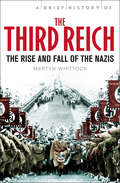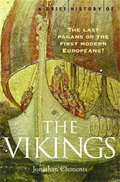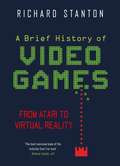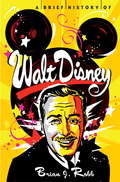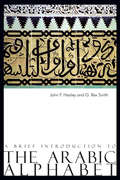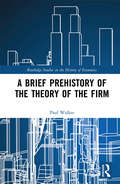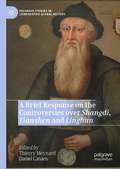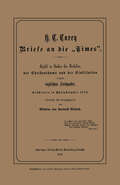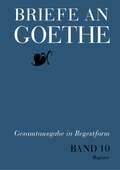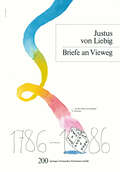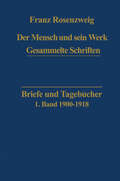- Table View
- List View
A Brief History of The Third Reich: The Rise and Fall of the Nazis (Brief Histories)
by Martyn WhittockBeginning in the broken aftermath of the First World War and the Treaty of Versailles that made German recovery almost impossible, Whittock tells not just the account of the men who rose to the fore in the dangerous days of the Weimar republic, circling around the cult of personality generated by Adolf Hitler, but also a convincing and personality-driven overview of how ordinary Germans became seduced by the dreams of a new world order, the Third Reich. The book also gives a fascinating insight into the everyday life in Germany during the Second World War and explores key questions such as how much did the Germans know about the Holocaust and why did the regime eventually fail so disastrously?
A Brief History of the Tudor Age (Brief Histories)
by Jasper RidleyFrom the arrival of Henry Tudor and his army, at Milford in 1485, to the death of the great Queen Elizabeth I in 1603, this was an astonishingly eventful and contradictory age. All the strands of Tudor life are gathered in a rich tapestry - London and the country, costumes, furniture and food, travel, medicine, sports and pastimes, grand tournaments and the great flowering of English drama, juxtaposed with the stultifying narrowness of peasant life, terrible roads, a vast underclass, the harsh treatment of heretics and traitors, and the misery of the Plague.
A Brief History of the Vikings: The Last Pagans Or The First Modern Europeans? (Brief Histories)
by Jonathan Clements'From the Fury of the Northmen deliver us, O Lord.'Between the eighth and eleventh centuries, the Vikings surged from their Scandinavian homeland to trade, raid and invade along the coasts of Europe. Their influence and expeditions extended from Newfoundland to Baghdad, their battles were as far-flung as Africa and the Arctic. But were they great seafarers or desperate outcasts, noble heathens or oafish pirates, the last pagans or the first of the modern Europeans? This concise study puts medieval chronicles, Norse sagas and Muslim accounts alongside more recent research into ritual magic, genetic profiling and climatology. It includes biographical sketches of some of the most famous Vikings, from Erik Bloodaxe to Saint Olaf, and King Canute to Leif the Lucky. It explains why the Danish king Harald Bluetooth lent his name to a twenty-first century wireless technology; which future saint laughed as she buried foreign ambassadors alive; why so many Icelandic settlers had Irish names; and how the last Viking colony was destroyed by English raiders. Extending beyond the traditional 'Viking age' of most books, A Brief History of the Vikings places sudden Scandinavian population movement in a wider historical context. It presents a balanced appraisal of these infamous sea kings, explaining both their swift expansion and its supposed halt. Supposed because, ultimately, the Vikings didn't disappear: they turned into us.
A Brief History of the Wars of the Roses (Brief Histories)
by Mr Desmond SewardDuring the fifteenth century England was split in a bloody conflict between the Houses of York and Lancaster over who should claim the crown. The civil wars consumed the whole nation in a series of battles that eventually saw the Tudor dynasty take power. In A Brief History of the Wars of the Roses, Desmond Seward tells the story of this complex and dangerous period of history through the lives of five men and women who experienced the conflict first hand. In a gripping narrative the personal trials of the principal characters interweave with the major events and personalities of one of the most significant turning points in British history.
A Brief History of Universities
by John C. MooreIn this book, John C. Moore surveys the history of universities, from their origin in the Middle Ages to the present. Universities have survived the disruptive power of the Protestant Reformation, the Scientific, French, and Industrial Revolutions, and the turmoil of two world wars—and they have been exported to every continent through Western imperialism. Moore deftly tells this story in a series of chronological chapters, covering major developments such as the rise of literary humanism and the printing press, the “Berlin model” of universities as research institutions, the growing importance of science and technology, and the global wave of campus activism that rocked the twentieth century. Focusing on significant individuals and global contexts, he highlights how the university has absorbed influences without losing its central traditions. Today, Moore argues, as universities seek corporate solutions to twenty-first-century problems, we must renew our commitment to a higher education that produces not only technicians, but citizens.
A Brief History of Venice (Brief Histories)
by Professor Elizabeth HorodowichIn this colourful new history of Venice, Elizabeth Horodowich, one of the leading experts on Venice, tells the story of the place from its ancient origins, and its early days as a multicultural trading city where Christians, Jews and Muslims lived together at the crossroads between East and West. She explores the often overlooked role of Venice, alongside Florence and Rome, as one of the principal Renaissance capitals. Now, as the resident population falls and the number of tourists grows, as brash new advertisements disfigure the ancient buildings, she looks at the threat from the rising water level and the future of one of the great wonders of the world.
A Brief History Of Video Games: From Atari to Virtual Reality (Brief Histories)
by Rich Stanton'Stanton writes with terrific verve and precision . . . his understanding of the seductive pleasures of gaming takes us right to its heart.'Maria Bustillos, Times Literary Supplement'The best overview book of the industry that I've read.'Andrew Liptak, io9From the first wood-panelled Pong machines in California to the masterpieces of engineering that now sit in countless homes all over the world, A Brief History of Video Games reveals the vibrant history and culture of interactive entertainment. Above all, this is a book about the games - how the experience of playing has developed from simple, repetitive beginnings into a cornucopia of genres and styles, at once utterly immersive and socially engaging. With full-colour illustrations throughout, it shows how technological advances have transformed the first dots and dashes of bored engineers into sophisticated, responsive worlds that are endlessly captivating. As thrilling and surprising as the games it describes, this is an indispensable read for anyone serious about the business of having fun.
A Brief History of Walt Disney (Brief Histories)
by Brian RobbBoth a fascinating account of Walt Disney’s own significant artistic creations, from the iconic Mickey Mouse to the groundbreaking Snow White in 1937, and an insightful history of the hugely successful entertainment behemoth he created, from Dumbo to Pixar’s Toy Story, as well as the hugely popular theme parks. But Disney’s dark side is also explored: his disputed parentage; industrial disputes; his work for the FBI; and his anti-Communist and allegedly racist and antisemitic views.The company Disney built is today stronger than ever, encompassing not only the ongoing legacy of Disney animation, but also acting as the guardian of other well-loved creative endeavours, such as Pixar, The Muppets, Marvel Comics and now Star Wars.Sections include ‘Before Mickey: The Road to the Mouse House’, covering from 1901 to 1945 – the creation of Mickey Mouse, the creation of the world’s first full-length animated feature film, the Golden Age of animation and Disney’s help for the American war effort, despite labour disputes; ‘Disney Studios: The Disney Genius’ – difficult times, theme parks and television, live-action movies, including Mary Poppins; ‘Animation’s Second Coming’, from the Lady and the Tramp to The Sword in the Stone, and Walt Disney’s death; ‘After Walt: The Disney Legacy’ – family attempts to keep the studio afloat, decline and the loss of lustre in the 1970s and 1980s; ‘Disney Resurgent’ – a triumphant rebirth under new management with Who Framed Roger Rabbit? The Lion King and other blockbuster hits; ‘From Eisner to Iger’ – the corporate battle for the soul of Disney; ‘Disney Goes Digital’ – from Pixar to Star Wars, via Marvel Comics and The Muppets, Disney buyy up other studios, themselves often enough inspired by the original.
A Brief Illustrated History of Machines and Mechanisms (History of Mechanism and Machine Science #10)
by Emilio Bautista Paz Marco Ceccarelli Javier Echávarri Otero José Luis Muñoz SanzMachines have always gone hand-in-hand with the cultural development of m- kind throughout time. A book on the history of machines is nothing more than a specific way of bringing light to human events as a whole in order to highlight some significant milestones in the progress of knowledge by a complementary persp- tive into a general historical overview. This book is the result of common efforts and interests by several scholars, teachers, and students on subjects that are connected with the theory of machines and mechanisms. In fact, in this book there is a certain teaching aim in addition to a general historical view that is more addressed to the achievements by “homo faber” than to those by “homo sapiens”, since the proposed history survey has been developed with an engineering approach. The brevity of the text added to the fact that the authors are probably not com- tent to tackle historical studies with the necessary rigor, means the content of the book is inevitably incomplete, but it nevertheless attempts to fulfil three basic aims: First, it is hoped that this book may provide a stimulus to promote interest in the study of technical history within a mechanical engineering context. Few are the co- tries where anything significant is done in this area, which means there is a general lack of knowledge of this common cultural heritage.
A Brief Introduction to Astronomy in the Middle East (A\brief Introduction Ser.)
by John M. SteeleThe Middle East is the birthplace of astronomy and the centre for its development during the medieval period. In this brief introduction John Steele offers an intriguing insight into Middle Eastern achievements in astronomy and their profound influence on the rest of the world. Amongst other things, the book traces the Late Babylonians' ingenious schemes for modelling planetary motion. It also reveals how medieval Islamic advances in the study of the heavens, and the design of precise astronomical instruments, led to breakthroughs by Renaissance practitioners such as Copernicus and Kepler. An invaluable introduction to one of the oldest sciences in the world.
A Brief Introduction to The Arabic Alphabet
by John F. Healey G. Rex SmithThe Arabic alphabet has a rich history, one that is closely linked with the development of culture and society in the Middle East. In this comprehensive introduction the authors trace the origins of the Arabic alphabet back to Aramaic, which also gave rise to the Hebrew and Greek alphabets. Using detailed illustrations the authors investigate early Arabic papyri and early Islamic inscriptions as well as classical Arabic scripts. John F. Healey and G. Rex Smith bring the story up to the present day by examining the practice of calligraphy, printing and computing in Arabic.
Brief Lives (Vintage Contemporaries Ser.)
by Anita Brookner'I never liked her, nor did she like me; strange, then, how we managed to keep up a sort of friendship for so long.'Fay Langdon has relinquished her singing career to marry Owen, a highly successful solicitor. At one of their dinner parties Fay meets the glamorous, self-obsessed Julia and is destined to join the handful of acolytes who provide Julia with ammunition for her merciless scorn and disapprobation. As the years pass and Fay and Julia's lives grow empty of purpose, they are drawn together by their fear of age and isolation. Yet a mutual mistrust continues to exist between them until Fay is driven to one last heroic act.
Brief Lives: An Intimate And Very Personal Portrait Of The Twentieth Century
by Paul JohnsonIn the course of a long and successful career as a journalist and author, Paul Johnson has known popes, presidents, prime ministers, painters, poets, playwrights, even the foul-mouthed publican Muriel Belcher, who ran the legendary Colony Club. Harking back to the scandalously anecdotal 17th century book by John Aubrey on the celebrities of his times, Brief Lives is the distilled essence of Johnson's experience of a complex variety of people who have contributed to our political, spiritual and cultural life.He advised Margaret Thatcher, counselled Princess Diana, had a drawing of him done by Ernest Hemingway and enjoyed the company of John Osborne, Arnold Wesker and Harold Pinter at Buckingham Palace. He has been an insider, outside observer and universal commentator on the individuals who have changed history, formed public taste or simply lightened our lives by their presence.
A Brief Natural History of Civilization: Why a Balance Between Cooperation & Competition Is Vital to Humanity
by Mark BertnessA compelling evolutionary narrative that reveals how human civilization follows the same ecological rules that shape all life on Earth Offering a bold new understanding of who we are, where we came from, and where we are going, noted ecologist Mark Bertness argues that human beings and their civilization are the products of the same self-organization, evolutionary adaptation, and natural selection processes that have created all other life on Earth. Bertness follows the evolutionary process from the primordial soup of two billion years ago through today, exploring the ways opposing forces of competition and cooperation have led to current assemblages of people, animals, and plants. Bertness’s thoughtful examination of human history from the perspective of natural history provides new insights about why and how civilization developed as it has and explores how humans, as a species, might have to consciously overrule our evolutionary drivers to survive future challenges.
A Brief Prehistory of the Theory of the Firm (Routledge Studies in the History of Economics)
by Paul WalkerThe theory of the firm did not exist, in any serious manner, until around 1970. Only then did the current theory of the firm literature begin to emerge, based largely upon the work of Ronald Coase and to a lesser degree Frank Knight. It was work by Armen Alchian, Robert Crawford, Harold Demsetz, Michael Jensen, Benjamin Klein, William Meckling and Oliver Williamson, among others, that drove the upswing in interest in the firm among mainstream economists. This accessible book provides a valuable overview of the ‘prehistory’ of the firm. Spanning an impressive timeline, it delves into Antiquity, the Medieval era, the pre-classical economics period and the 19th and 20th centuries. Next, the book traces the theoretical contributions from pre-classical, classical and neoclassical economics. It will be illuminating reading for students and researchers of the history of economic thought, industrial organization, microeconomic theory and business history.
A Brief Prehistory of the Theory of the Firm (Routledge Studies in the History of Economics)
by Paul WalkerThe theory of the firm did not exist, in any serious manner, until around 1970. Only then did the current theory of the firm literature begin to emerge, based largely upon the work of Ronald Coase and to a lesser degree Frank Knight. It was work by Armen Alchian, Robert Crawford, Harold Demsetz, Michael Jensen, Benjamin Klein, William Meckling and Oliver Williamson, among others, that drove the upswing in interest in the firm among mainstream economists. This accessible book provides a valuable overview of the ‘prehistory’ of the firm. Spanning an impressive timeline, it delves into Antiquity, the Medieval era, the pre-classical economics period and the 19th and 20th centuries. Next, the book traces the theoretical contributions from pre-classical, classical and neoclassical economics. It will be illuminating reading for students and researchers of the history of economic thought, industrial organization, microeconomic theory and business history.
A Brief Response on the Controversies over Shangdi, Tianshen and Linghun (Palgrave Studies in Comparative Global History)
by Thierry Meynard Daniel CanarisThis book represents the first critical edition and scholarly annotated translation of a pioneering report on the predicament of cross-cultural understanding at the dawn of globalization, titled “A Brief Response on the Controversies over Shangdi, Tianshen and Linghun” (“Resposta breve sobre as Controversias do Xámtý, Tien Xîn, Lîm hoên”), which was written in China by the Sicilian Jesuit missionary Niccolò Longobardo (1565–1654) in the 1620s and profoundly influenced Enlightenment understandings of Asian philosophy. The book restores the focus on Longobardo’s own intellectual concerns, while also reproducing and analyzing all the Chinese-language annotations on the previously unpublished Portuguese and Latin manuscripts. Moreover, it meticulously modernizes all romanizations with standard Hanyu pinyin and identifies, on the basis of archival research, most of Longobardo’s Chinese interlocutors, thus providing new insights into how the Jesuits networked with Chinese scholars in the late Ming. In this way, it opens up this seminal text to Sinologists and global historians exploring Europe’s first intellectual exchanges with China. In addition, the book presents four introductory essays, written by the editors and two prominent scholars on the Jesuit China mission. These essays comprehensively reconstruct the historical and intellectual context of Longobardo’s report, stressing that it cannot be viewed purely as a product of Sino-European cultural exchange, but also as an outgrowth of both exegetic debates within Europe and of European experiences across Asia, especially in Japan. Hence this critical edition will greatly contribute to a more globalized view of the Jesuit China mission.
A Brief Summe of Geographie, by Roger Barlow (Hakluyt Society, Second Series)
by E.G.R. TaylorTranscript of the manuscript dedicated to Henry VIII (Royal mss. 18 B. XXVIII), with a pedigree of Barlow, edited with an introduction and notes. Barlow's translation of Enciso's Suma de geographia, with much original and supplementary matter by him. This is a new print-on-demand hardback edition of the volume first published in 1932.
A Brief Summe of Geographie, by Roger Barlow (Hakluyt Society, Second Series)
by E. G. R. TaylorTranscript of the manuscript dedicated to Henry VIII (Royal mss. 18 B. XXVIII), with a pedigree of Barlow, edited with an introduction and notes. Barlow's translation of Enciso's Suma de geographia, with much original and supplementary matter by him. This is a new print-on-demand hardback edition of the volume first published in 1932.
Briefe an die „Times”: Replik in Sachen des Verkehrs, des Christenthums und der Civilisation contra englischen Freihandel
by Wilhelm Von Kardorff-WabnitzBriefe an Goethe: Band 10: 1823–1824 (10/1 Regesten + 10/2 Register)
Die Gesamtausgabe der Briefe an Goethe in Regestform erschließt mehr als 19.800 Briefe von etwa 3.500 Absendern. Die bisher erschienenen neun Bände umfassen den Zeitraum 1764 bis 1822 und präsentieren über 14.000 Briefregesten. Das mehrgliedrige Regest informiert über den Inhalt des Briefes und stellt ihn in den Zusammenhang von Goethes persönlichen Korrespondenzbeziehungen. Die Briefregesten werden durch Orts-, Personen- und Werkregister ergänzt. Band 10 dokumentiert Goethes persönliche Korrespondenz in den Jahren 1823 und 1824. Er umfasst die Regesten von fast 1.100 Briefen von 448 Absendern.
Briefe und Tagebuchaufzeichnungen Willy Kükenthals von seiner Reise in den Malaiischen Archipel 1893–1894
by Sybille BauerIn diesem Buch finden Sie die von Willy Kükenthal, dem berühmten deutschen Zoologen und Forschungsreisenden, erhaltenen Briefe, die er während seiner Reise in den Malaiischen Archipel Ende des 19. Jahrhunderts an seine Frau geschrieben hat und ein auf Borneo geführtes wissenschaftliches Tagebuch. Giftmischende Malayen auf Halmahera, kopfjagende Alfuren in Borneo, Fiebersümpfe, Moskitoschwärme und Blutegel – über fast alles hat er seine Frau, wenn auch oft diplomatisch, in Kenntnis gesetzt. Die Methoden der Penisperforation jedoch vertraute er nur seinem Tagebuch. an. Die Dokumente seiner Reise geben einen Einblick in die Erfahrungen, die Willy Kükenthal während seiner Abenteuer in Südostasien gemacht hat. Sie sind ein eindrucksvolles Zeugnis der Forschung im 19. Jahrhundert. Die Briefe und das Tagebuch zeigen, unter welch extremen Bedingungen Zoologen aus Kükenthals Generation forschten, um Sammlungen für Museen zusammenzustellten.
Briefe und Tagebücher (Franz Rosenzweig Gesammelte Schriften #1)
by U. RosenzweigDas Erscheinen der Gesammelten Schriften Franz Rosenzweigs stellt ein Ereignis von besonderem geistigen Rang dar. Denn es ist ganz unbestritten, daß Franz Rosenzweig zu den bedeutend sten jüdischen Denkern unseres Jahrhunderts gehört, ja, daß er vermutlich sogar weit über unsere Epoche hinaus von Bedeutung sein wird. E. Levinas hat Rosenzweig nicht zu Unrecht Gestalten wie Blaise Pascal und Sören Kierkegaard an die Seite gestellt!. Gleichwohl ist das Werk Rosenzweigs bis jetzt nur schwer zu gänglich gewesen. Und zwar nicht nur aus den Gründen, derent wegen auch sonst ein Werk, das Entscheidendes zu sagen hat, seine Zeit braucht, bis es zugänglich wird, sondern auch deshalb, weil sich dem Schicksal des Werkes Rosenzweigs die leidvollen Spuren der jüdischen Emigration deutlich eingegraben haben. Franz Rosenzweig starb 42-jährig im Dezember 1929, drei Jahre vor dem Ausbruch der braunen Diktatur. Edith Rosen zweig, seine Gattin, konnte zwar 1935 und 1937 noch die Kleine ren Schriften und eine Auswahl aus Rosenzweigs Briefen ver öffentlichen. Die beiden Bände gehören zu den wenigen umfang reicheren von Juden verfaßten Büchern, deren Druck in jenen Jahren möglich war. An weitere Veröffentlichungen war damals aber nicht zu denken.
Briefe von und an Lassalle bis 1848
by Gustav MayerDieser Buchtitel ist Teil des Digitalisierungsprojekts Springer Book Archives mit Publikationen, die seit den Anfängen des Verlags von 1842 erschienen sind. Der Verlag stellt mit diesem Archiv Quellen für die historische wie auch die disziplingeschichtliche Forschung zur Verfügung, die jeweils im historischen Kontext betrachtet werden müssen. Dieser Titel erschien in der Zeit vor 1945 und wird daher in seiner zeittypischen politisch-ideologischen Ausrichtung vom Verlag nicht beworben.
